This week we’re looking at how to play Bossa Nova bass lines. We’re breaking down the most popular Bossa Nova, The Girl From Ipanema by Antonio Carlos Jobim (most famously sung by Astrud Gilberto).
The Bossa Nova Stereotype
Those of you that have taken any kind of cocktail gigs will have, at some point, had to play a Bossa Nova. It’s a style that some of you will unfortunately associate with elevator music. But if you can get past that modern stereotype you’ll find a great Brazilian style that’s lovely to play, full of rich harmony and a perfect laidback vehicle for working on many aspects of your playing.
The Girl From Ipanema
So in this lesson we’re going to look at probably the most famous Bossa Nova tune, The Girl From Ipanema by Antonio Carlos Jobim.
The tune is in F major for the most part and we’re going to just work through the progression several times trying a few different rhythmic patterns out as we read through the chord symbols.
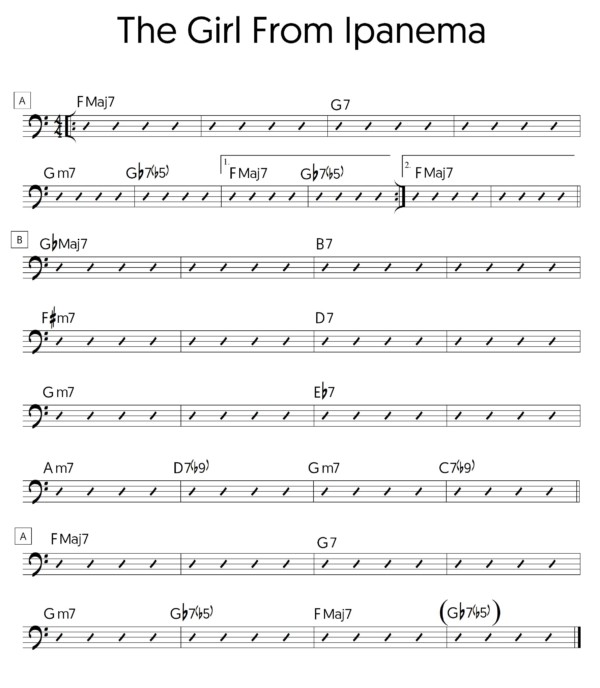
Practice Track:
Two Feel
Let’s first look at the most basic pattern you could use for a Bossa. The simple Two Feel. We’re going to play a root note on beat 1 and the fifth of the chord on beat 3.
Note: Many bass players will actually bypass this rhythm when studying Bossa Nova and go straight into the busier, more familiar latin pattern. But I’d recommend trying a simple two feel first because it’s a way of setting up a more laidback feel as our foundation and it’s used a lot in many double bass Bossa lines including original Astrud Gilberto recording of The Girl From Ipanema (have a listen!)
The Root Fifth Pattern – That Ol’ Chestnut!
To play this two feel we’ll be using a root fifth pattern. We have two common fingerings for the fifth, above the root and below the root. Below are two examples on a root note of C:
Above The Root
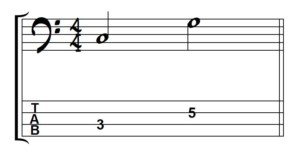
Below The Root
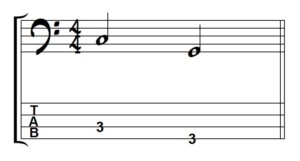
For our first chord of Fmaj7 we could use these two basic patterns in a our low first position for getting started:
Low Root Note
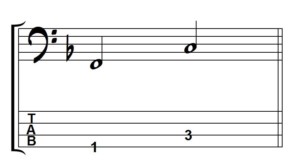
High Root Note
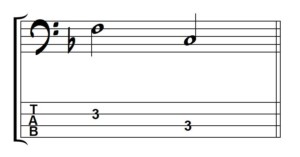
Remember we’re improvising a bass line here. You make the decisions. So try experimenting with different root notes and different fifths as a way of developing your vocabulary and style.
The Flattened Fifth
Most of the chords in this tune contain a normal perfect 5th. But we do have the chromatic passing chord of Gb7b5 that contains the flattened 5th.
Note: I would normally see this as a Gb7#11 but we’ll go with the Real book method of writing it as a 7b5 chord just for the purpose of this lesson so you can get some practice at playing Root-b5 patterns.
The Root to Flattened Fifth pattern on a low Gb is as follows:
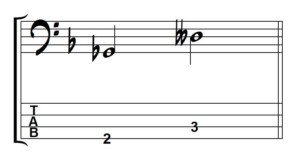
Exercise: Play a Two Feel through The Girl From Ipanema progression (chart and track above)
The Common ‘Bossa’ Bass Pattern
The most common way to approach a Bossa Nova is by using a dotted quarter – 8th note figure as seen below on an F:
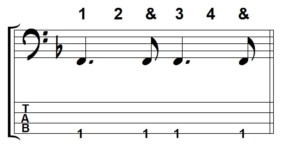
It’s also common to choke the note on beats 2 and 4 to give more of a bounce to the groove:
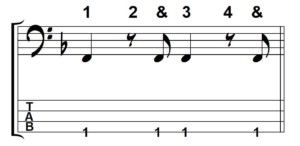
When we add the 5th of the chord into the groove we find the following bass figure (on an Fmaj7):
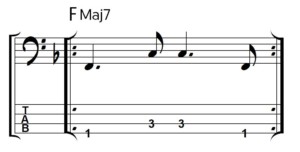
Exercise: Play through The Girl From Ipanema progression using the above groove
Variations
As well as the basic Root-Fifth groove mentioned it’s also possible to make use of various melodic and rhythmic variations to add some musical interest (see video).
However, be careful when using these variations. The bossa nova is a relatively laidback style and too much movement in the bass line could be seen as overplaying by other band members or band leaders!
It’s fine to practice more syncopated rhythms and arpeggio/scalar lines as an academic study but take care when applying these techniques on a gig. Listen to the music around you and hear your bass lines in the overall mix as if you are an audience member.













Great Bossa lesson Mark. I have to play Girl from Imanima on Tuesday with the Titanic Jazz Band at the Donkey in Leicester on Tuesday so perfect timing.
Thanks a lot Mark, very helpfule, a similar course on salsa rythm would be great !
What A and B in squares mean? What do 1 and 2 lines mean?
Hi XerX, I can answer that :)
A and B means the structure of the song. The A parts (beginning and end) has the same melody, while the B part is different. Try and listen to the song: https://www.youtube.com/watch?v=c5QfXjsoNe4 – and you can hear it :)
The 1 and 2 means the following. There are repeating signs at the first A part. So the first time you play the A part you play the end 1 and the second time you play the A part you use end 2. I hope you understand my English. I don’t know the correct music terms in English to describe my point :)
Thank you.
I have difficulties identifying scales
Hi Mark,
Thank you for a great introduction to playing the bossa nova. And it’s a great backing track of The Girl from Ipanema – but is there somewhere I can download the track? – because I’m practising in a basement underground where there is no internet, and furthermore I need to put it in Amazing Slowdowner so that I can practice in a slower tempo.
Hey Mark,
Great lesson. And I would like to echo @Inger Hindhede Kjær’s request for a downloadable backing track to this lesson. Is that possible?
Thanks,
Ed
Mark,
You mention backing tracks in many of your videos. I have yet to find them. Would you tell me where they are?
Thanks. I finally see the little red button with the practice track.
Ha. Love it. My parents always used to play the Girl From Ipanema version on the Stan Getz album. I used to love listening to it and being bilingual I know the lyrics by heart Playing the bass along to it here provided me with a nicer flavour than any Banana Daiquiri I’ve ever had. Thing is most of my muso colleagues consider it to be boring ‘elevator music’. Each to their own but for anyone with an interest in jazz and wishing to experiment with different rhythms and textures this is surely a must. Not to mention the advantage should you get any cocktail bar gigs. Todo Bem amigos bajistas!!!
Great track. Been a drummer all my life and this C-19 thing came around, so switching it up with the bass….Love the GFI, Stan G and C. Jobim stuff. I never thought I could sound so professional, with your help/lessons!! Great stuff Mark!!
Genial me encanto la clase muy explicativo y detallista
Genial me encanto la clase muy explicativo y detallista, recomendable